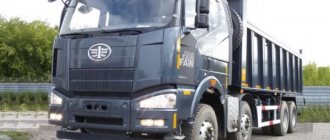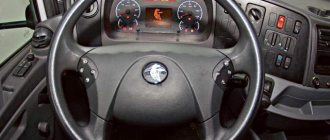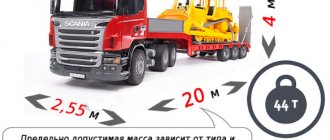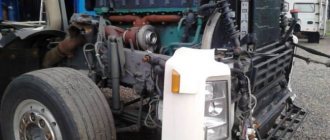For heavy cargo transportation over long distances, the best solution is the Volvo FH16, which is capable of moving at high speed over difficult road terrain. A powerful tractor is part of a road train along with vans, platforms, and refrigerators.
The vehicle is distinguished by excellent driving performance, durability, fuel efficiency, safety and reliability. It is designed to operate under all conditions without compromising performance.
Internal power is complemented by an attractive exterior. The black main color tone with halftones is set off by chrome elements of the handles, radiator grille, steps, and emblems.
About the history of the model
VolvoTrucks is a transnational engineering corporation with official representative offices in 140 countries around the world. The main production and design offices are located in Sweden, Belgium, USA, China and Brazil. Volvo truck assembly plants are organized in many countries around the world, including Russia.
Despite its global presence on all continents, the largest share of Volvo truck sales still comes from Western Europe. But even in the United States, despite the presence of serious American competitors, a third of the trucks produced are sold. In Russia, Volvo trucks (flagship FH series, and especially after 2008) are able to be purchased and operated by transport enterprises and individuals only with very good financial capabilities.
In general, the modern model range of VolvoTrucks trucks is represented by the following series: Volvo FL, Volvo FE, Volvo FH. The first production vehicles of the FH family rolled off the company's assembly lines in 1993. Modernizations of the FH series, in accordance with current technical advances and environmental standards, were carried out in 1998, 2001, 2005, 2008, 2012. There was a smooth and systematic evolution of the series, which was successful on the market.
The sixth generation of heavy FH trucks from VolvoTrucks was introduced at the very end of 2012. According to the creators, they sought to build the car in such a way that “everything remains the same as it was in the previous generation, but gets better.”
It was not easy: after 19 years, the structure had practically exhausted all its internal resources. Another tightening of environmental standards in Europe has led to major changes in the layout of components and assemblies, primarily related to the engine cooling system and exhaust gas circulation. This required increasing the space for the engine layout in the front part and in the engine tunnel area.
In order to “insert” the world’s most powerful diesel for a truck into the design of an FH series vehicle, and even use new equipment for Euro-4...5, it was necessary to either reduce the living space of the cabin or sacrifice aerodynamics. Both were unacceptable, and a completely new cabin was developed for the Volvo FH16.
This cabin has a new power frame, different proportions, height and internal volume, which has increased by one cubic meter. The tilt of the pillars is now visually absent, and this has a positive effect on visibility. In addition, the front pillars have become very thin. However, in total, the result was a frame no less rigid than that in the cabin with massive “beams” of the front pillars. There is no doubt about this, because... The issue of ensuring security in Europe is treated more than scrupulously.
By the way, in terms of the use of various additional electronic safety systems, the Volvo FH16 can also be called a record holder (they will be discussed below). This car is the modern embodiment of reliability and safety. And style too: the most thoughtful equipment and rich cabin trim, a strictly maintained exterior of the car, decorated with chrome parts and especially impressive in black with “Mystik Fjord” undertones, claim leadership in the entire segment and in terms of style.
Maintainability and maintenance
Reviews from Volvo FH16 owners indicate the high reliability of the truck. The car has a strong suspension, the car's electronics also work flawlessly.
Thanks to the company’s popularity, a large network of certified service centers has spread out in Russia and abroad, where you can undergo scheduled maintenance and repairs.
Attention! High reliability of the truck saves significant amounts on constant repair work. However, you should follow the manufacturer's recommendations and undergo technical inspection and maintenance in accordance with the time periods established by the company.
As for the scheduled replacement of engine oil, filters and other consumables, the intensity of use of the vehicle should be taken into account. On average, it is recommended to replace consumables and fluids every 100,000-150,000 kilometers.
It is practically impossible to repair the Volvo FH16 on your own, since the car has high-tech complex electronic systems in its design. The machine is serviced in service centers, which prevents major breakdowns and failure of electronics.
The model has a high build quality, even in cars with high mileage, the cabin does not rattle or knock, insulates sound well, and retains heat inside the cabin. There are no questions about the driving performance of used cars (provided that the previous owner complied with the scheduled maintenance deadlines). Major repairs of a truck engine are performed after 700,000-1,000,000 vehicle miles.
Purpose and scope of application "Volvo FH16"
In a practical sense, this is a vehicle for transporting significant volumes of cargo, intended for large transport companies. In their reliable hands, it is able to demonstrate its high efficiency as efficiently as possible, capable of towing a road train with a total weight from 44 tons to 85 tons (in versions with top-end engines). Naturally, the use of such a large-capacity truck significantly reduces the costs of long-distance transportation of large consignments of cargo. The highly durable frame, made from chrome-molybdenum steel, is backed by a lifetime warranty.
As a truck tractor, this truck works as part of a road train together with various types of vans, refrigerators, tankers, semi-trailers for transporting heavy equipment, and dump platforms too. Various types of equipment applicable in construction, industry, and logging are also installed on the Volvo FH16 chassis. Volvo FH16 vehicles can be made with the following wheel configurations – 4×2; 6x2; 6x4; 8x4.
A powerful diesel engine, combined with modern control and safety systems with sophisticated suspension settings, ensures uniformly fast movement when loaded, even on roads with difficult terrain (beams, descents, ascents), without a significant reduction in speed. And also in any weather, and on roads with poor-quality hard surfaces.
Basic technical specifications
The vehicle can have several types of wheel configuration: 4×2; 6x2; 6x4 or 8x4.
List of main technical characteristics of the Volvo FH 16:
Dimensions Volvo FH 16
- The maximum permissible speed is 90 km/h;
- The maximum load on the rear axle is 26 tons, and on the front axle – 8 tons;
- The wheelbase is 3.6 m;
- Trailer weight – 9 t;
- The total weight of the truck is 44 tons;
- Dimensions : length – up to 7 m, width – 2.5 m, height – up to 3.9 m.
Engines "Volvo FH16"
The new Volvo FH16 trucks are equipped with two types of engines – D13C and D16G. These are six-cylinder in-line liquid-cooled diesel engines, with a turbocharger, turbo compound, and intercooler; working volume of 12.8 dm³. Both of these engines comply with Euro-5 environmental standards.
The D13C compression ratio is 17.8:1; "D16G" - 16.8:1. The diameter of the “D13C” cylinder is 131 mm; "D16G" - 144 mm. Each of the above engine models has 2 full-flow and 1 part-flow oil filters. The volume of oil required for replacement, including the filter, is 33 l for the D13C and 42 l for the D16G.
The total volume of the cooling system is: 38 liters for the D13C and 48 liters for the D16G. There are clear requirements for the quality of diesel fuel: the “ULSD” standard (ultra-low sulfur diesel fuel, maximum sulfur content - no more than 10 parts per million). The frequency of engine oil changes is set by the manufacturer as 100,000 km or once a year when using VDS4 oil.
How does turbocompound work?
Turbocompound is a classic recirculation system. It converts and uses energy that previously simply, literally, went down the drain. The “waste energy” is not thrown into the exhaust pipe: a second turbine, which is installed behind the turbocharger and driven by the exhaust gases, takes additional heat from these gases.
The second turbine of the turbo compound rotates at speeds of up to 55 thousand revolutions per minute. This motion energy is transmitted through turbine gears and a hydraulic coupling, and then through the timing gears to the crankshaft. These rotational transmissions create a useful increase in torque, which is reflected in the change in torque at the flywheel. Provides additional traction without significantly increasing diesel fuel consumption.
Both engine variants demonstrate impeccable adaptability to different operating modes. The rotation of the crankshaft is complemented by the constant transmission of forces from the turbo compound. This helps to equalize load pulsations, which are caused by periodic combustion strokes in the cylinders. Thanks to this, the engine runs smoother and smoother, and the effective torque range is significantly expanded.
Volvo Trucks provides consumers with a wide range of engine power options for the Volvo FH16 truck. Both engine options combine different power modes: 540, 600, 700 or 750 horsepower and 2800, 2800, 3150 or 3550 N•m of torque, respectively. This makes it easier to select the power mode required for specific transport applications.
Volvo FH16 engines also feature such design solutions as exhaust gas recirculation, AdBlue injection, and a particulate filter. Volvo FH16 engines have direct fuel injection. Their designs use single cylinder heads and camshafts located on top. The electronically controlled unit injectors provide injection pressures of up to 2400 bar with perfect synchronization thanks to the EMS engine management system.
The closed crankcase ventilation system ensures uninterrupted recirculation of crankcase gases. The rear drive mechanism features a compact and lightweight design, driven by an air compressor - together with the power steering, oil and fuel pumps.
Volvo FH16 trucks can be equipped with steel or aluminum fuel tanks with a capacity range from 150 to 900 liters. The maximum intended volume for the Volvo FH16 truck tractor, when using the main and additional fuel tanks, is 1480 liters. The tank for the AdBlue reagent, with a built-in AdBlue pump, is made of plastic and has a capacity of 32 to 100 liters.
Transmission
The Volvo 16 tractor is equipped with a modern and reliable I-Shift gearbox. When interacting with the engine, it reduces fuel consumption during high-speed driving. The automatic system allows you to perform a number of related tasks. Also, in order to reduce consumption, an I-Roll installation is provided.
The second gearbox option is a mechanical system with 14 steps, an auxiliary separator and a range-shifter. Its advantage is the reduction of noise and vibration levels when driving.
Optionally, the manufacturer offers to install more powerful and reliable axles on the Volvo FSh16, which have a positive effect on cost savings when caring for equipment. They reduce power losses during transmission from the engine to the axle, and are also equipped with a 1-stage gearbox.
Volvo FH 16 truck
Return to content
Transmission and axles "Volvo FH16"
Volvo FH16 trucks are available with both a 14-speed manual and a 12-speed I-Shift automatic transmission. These are gearboxes with a divider and range, with two reduction gears, four reverse speeds and automatic shifting. Patented servo-assisted synchronizers ensure effortless shifting. For gearboxes, installation of a compact retarder, power take-off, emergency power steering pump, and oil cooler is provided.
Of course, I-Shift is not a simple manual gearbox. Its secret lies in the electronic control unit. This ECU is responsible for the pneumatic system that controls the clutch and gears. Continuously receiving real-time information about vehicle speed, acceleration, weight, road grades, required torque and other data, it makes every gear change with great precision.
The electronic control unit is connected to the motor, which in turn regulates the speed and enhances the engine braking effect, for consistently fast and comfortable gear changes. The I-Shift system can be equipped with a compact retarder, power take-off, emergency power steering pump and oil cooler.
The I-Shift transmission was designed specifically to save diesel fuel. This is a reduction in internal energy losses - they are indeed lower compared to a manual transmission. This is a gear change carried out in an economical operating mode with great precision, to ensure that the engine operates in the most efficient range of speed. The “I-Roll” function automatically turns off the engine when driving on descents and uses the inertia of the truck to save fuel.
Even greater diesel fuel savings are achieved when using the additional “I-See” option. It saves and systematizes information about the ascents and descents traveled. Based on this data, optimal acceleration and torque will be achieved before each climb, and the higher gear will remain engaged longer. When driving uphill, I-See uses available road terrain information to avoid unnecessary downshifts.
Just before the descent, the power train will temporarily disengage, allowing the Volvo FH16 to coast. This will save energy and minimize the need for braking. But it will be possible to save fuel even on unfamiliar routes. Because the I-See system relies not only on GPS maps, but also takes data from a cloud server. Assuming that the road has been previously driven by a truck, I-See will download the data and provide fuel saving opportunities without delay.
The clutch in the Volvo FH16 can be used as a single- or double-disc pull-out type. Rear axles of this model may vary in design, load, torque and other parameters. The most reliable are the so-called “dump” bridges. They are characterized by a spaced main gear, hub planetary gearboxes, interaxle and interwheel differential locks. The axle design is designed for increased loads and increased torque. For three-satellite axles, gear ratios range from 3.33 to 5.41. For reinforced axles from 3.61 to 7.21.
It is possible to lift the drive axle in a two-axle trolley. You can disable and raise the near rear axle in a two-axle bogie by pressing a button on the dashboard. This raise will help reduce fuel consumption and reduce the turning radius. Protection in case the car is loaded is also provided: then the system will not obey this command, and the bridge will automatically lower and connect.
Trailing rear axles are available in several configurations - fixed with single or double tires, self-steering or with active steering. Axial load is 7.5; 9.5 or 10 tons.
Features and Benefits
The main advantages of the machine include excellent driving properties, strength and safety. It is difficult to find analogues with similar qualities on the market for similar equipment.
Volvo 16 truck
Operator convenience is ensured by the ergonomic Volvo FSh 16 cab, which has three modifications. Installation of Globetrotter XL and Globetrotter is an option.
The design of the case is very attractive; its main distinguishing features include:
- rear window installed tinted. It emphasizes the modest dimensions of the car;
- original components and shapes that give the equipment a unique look. Elements coated with chrome are installed (radiator grille, front step, door handles), as well as a steel emblem of the manufacturer;
- the style is emphasized by the presence of a tinted element on the outer part of the case;
- the presence of a visor for sun protection, large Volvo FH 16 mirrors;
- Painted in a rich black color with undertones that become noticeable in certain lighting.
Volvo FSH 16 truck
Return to content
Steering, braking and control
The Volvo FH16 uses dynamic steering with torque overlap. It provides more steering force at low speeds, reduces steering wheel kickback and keeps the steering wheel straight when braking on non-uniform friction surfaces.
The steering wheel automatically returns to its original position both when moving forward and when moving in reverse. Dynamic steering is available for all configurations, including the version with dual front axles. It can also be installed in combination with independent front suspension.
The truck's brake system is pneumatic, electronically controlled, with disc mechanisms and a compact hydraulic retarder (brake force booster). The main braking system is assisted by auxiliary brakes (VEB+ engine brake and EPG special mountain brake). Due to this, the speed of movement can be increased during the trip, without compromising safety. The special “Blending” system will select and apply the appropriate brake option.
Multivariate
The new Volvo FH is available in many versions. This also applies to the range of engines - from 400 to 750 hp, and chassis options - 2- and 3-axle, and the highlight of the new series is the independent front suspension on double wishbones IFS, but there are also traditional options with a transverse beam, which are in turn divided into suspensions made on two- or three-leaf springs, as well as on semi-elliptical or pneumatic cylinders. On the day of the test drive, I was able to test a car with independent suspension on the roads. In addition, it has a rack-and-pinion steering mechanism - a kind of breakthrough in the heavy-duty truck industry. The independent suspension settings seemed too soft to me; this did not subjectively worsen handling compared to a rigid beam, but the behavior of the car changed. I can’t draw any conclusions for two main reasons: the truck is pre-production and the road is flat. You can fully appreciate the benefits of a multi-link only on winding and bumpy roads, which were not on my way in Sweden...
The car itself, of course, can be not only a tractor, but also a truck with a different number of axles, a van or a chassis.
For the convenience of working with the suspension during loading and unloading operations, the road train is equipped with a remote control system for the air suspension with a wireless remote control, which, when driving, is no longer stored at the lower left part of the driver's seat, but on the left front pillar of the windshield. Maneuvering has become more comfortable due to improved visibility compared to the previous model.
I am slowly putting the road train among the same beauties, but very different in internal content, despite the obvious external kinship: the buyer has plenty to choose from.
Optics: LED tail lights, front headlight with daytime running lights, additional lights on the roof
Technical characteristics of the Volvo FH16 750 (RZZOC2)
Engine:
| Volvo D16 G750; turbodiesel, I-6 16 123 750 at 1900 min-1 3550–1000 at 1500 min-1 |
Transmission:
| automated, I-SHIFT 12/1 |
| Suspension | Front spring, rear pneumatic |
| Brake system | Pneumatic with disc mechanisms, hydraulic retarder |
| Wheel formula | 6x2 |
| Tire size | 315/70 R22.5 |
| Fuel tank capacity, l | 600 |
| AdBlue tank capacity, l | 32 or 90 (on request) |
Suspension "Volvo FH16"
Volvo FH16 trucks are available in five chassis heights: ultra-low (810 mm), low (850 mm), medium (900 mm), high (1000 mm) and extra high (1200 mm). Wheelbase sizes range from 3700 to 4600 mm.
The front suspension of the truck is independent in the Volvo FH16 variants with 4x2, 6x2 and 6x4 wheel arrangements. This means that each front wheel is suspended separately from the other, on double wishbones with air springs, which contributes to unique handling. For most Volvo FH16s, their suspension design uses small-leaf parabolic springs. Depending on the wheel formula, 4, 6, or 8 cylinders are installed on the rear air suspension.
The car is equipped with an electronically controlled suspension, which provides increased transportation comfort and cargo safety. This electronic control system automatically adjusts the height, keeping the vehicle at a constant level and compensating for possible uneven load distribution. The height of the loading platform is manually adjustable.
Prices
A new third-generation truck, depending on the set of installed functions and modification of the truck, can be purchased for an amount from 9,500,000 rubles to 12,500,000 rubles. A used car will cost less. So, depending on the technical condition, mileage, characteristics, installed options, a third-generation model can be purchased for an amount from 5,000,000 to 7,500,000 rubles, while cars of previous generations will cost drivers from 2,000,000 rubles.
Due to its high cost, Volvo FSH16 is rarely rented out.
This is a reliable, powerful and comfortable large-capacity truck designed for long-haul cargo transportation.
Thanks to the universal cargo chassis (depending on the modification of the car, it has different heights), the car is universal: it is used in construction, in the field of cargo transportation, and for conducting business activities. The car is distinguished by the presence of a huge number of electronic systems that increase the safety of the driver and passengers, and also make the process of driving more convenient.
The third generation Volvo FH 16 began production in 2012, but to this day the car has not lost its relevance: a high level of comfort, unprecedented reliability and a futuristic, modern and stylish appearance make the truck truly popular.
Features of operation with additional security systems
Both Volvo cars and trucks have always been positioned as being maximally “armed” with a variety of safety systems. Of course, the brand’s flagship model is equipped with such “helpers” to the maximum.
For safety reasons, Volvo FH16 cabs are equipped with glass roofs, which can be used as an escape hatch in the event of a rollover. All elements of the cabin: steering wheel, instrument panel, trim - are made of energy-absorbing materials. The seat upholstery has fire-resistant properties. In a number of cases, active safety systems with electronic sensors and cameras will automatically prevent collisions or warn the driver of danger:
- LKS (Line Keeping Support) – will notify you about deviation from the lane;
- DAS (Driver Alert Support) - monitors the position of the steering wheel, the degree of influence on the pedals and the position of the car relative to road markings. An audible signal and a light indicator will warn about the beginning of a deviation from the direction and wake up the driver;
- ACC (Adaptive Cruise Control) – adaptive cruise control will maintain a safe distance in traffic;
- ESP - the exchange rate stability system will automatically redistribute the braking force on slippery roads or when cornering at high speed, preventing a dangerous roll that threatens to tip over the car.
- Special cornering lighting system. Immediately after turning on the turn signal, an additional side headlight lights up, which illuminates the space in the direction of the turn and visually expands visibility, which is especially important in bad weather conditions.
- The corresponding system (EBS) will help you move uphill.
- The Alcolock electronic lock (additional option) will not allow a drunk driver to drive.
- In any fire (literally) case, the automatic fire extinguishing system of the engine compartment will work.
Such solid equipment is designed to compensate as much as possible for all possible mistakes and miscalculations of the driver, the notorious “human factor”. Hydraulic power steering can be supplemented with optional electric power assisted active steering at an additional cost. Other interesting and necessary options (already in the database) include an electronically controlled brake center with a choice of disc or drum mechanisms; electric windows, digital tachograph, heated driver's seat, modern audio system, air conditioning, electrically heated and electrically adjustable exterior mirrors.
And yet, completely from the realm of recent science fiction. Using the new wireless communication technology introduced on the flagship Volvo Trucks series, it is possible to constantly monitor the wear of key components, and the overall condition of the vehicle too. According to the creators of this system, service center engineers will be able to remotely check the current “health” of various components and the Volvo FH16 car from their computer. If a part begins to wear out, service center specialists can contact the transport company in advance; agree on a date for maintenance; order and prepare a new part to replace the worn one. Whether this system will take root and whether it will be able to work effectively in the CIS is still unknown.
Modifications
The third generation machines have several modifications. First of all, the model is distinguished by the type of cabin installed:
- Volvo FH16 Globetrotter XL. The highest and most spacious cabin. Equipped with two sleeping places;
- Globetrotter. A cabin with increased dimensions and two berths;
- Standard cab. It is equipped with one sleeping place and has a relatively low height.
In addition, the truck is distinguished by the typical dimensions of the cargo chassis:
- Very low – 810 millimeters;
- Low – 850 millimeters;
- Average – 900 millimeters;
- High – 1000 millimeters.
Depending on the chassis of the car, the purpose of the car is also chosen. For example, an ultra-low chassis is typical for truck tractors.
Cabin "Volvo FH16"
The Volvo FH16 truck is equipped with four cab options.
- Sleeping cabin (CAB-SLP) with an internal height of 1.71 m, a height along the engine compartment lid of 1.62 m. Equipped with sleeping places for two people.
- Globetrotter cabin (Globetrotter CAB-HSLP) with sleeping places for two people and additional storage space. The internal height is 2.05 m, along the engine compartment lid - 1.96 m.
- The Globetrotter XL CAB-XHSL offers spacious sleeping accommodations for two people, increased height and more storage space. The internal height of this cabin is 2.2 m, along the engine compartment lid - 2.11 m. The glass area in this cabin has been increased by 17 percent.
- Low sleeper cab (CAB-LSLP) with suspension and additional cargo space above the cab. Its internal height is 1.47 m, along the engine compartment lid - 1.38 m.
The Volvo FH16 cabin is equipped with a four-point suspension; can be equipped with fully damped coil springs, coil springs at the front and air suspension at the rear, or full air suspension. The Volvo FH16 cabin is equipped with several style solutions: vinyl, textile, soft textile, leather, textile/leather and two-tone leather. Leather seats can be ordered with a ventilation function.
In the basic configuration, the driver's seat is equipped with a headrest, an adjustable and reclining backrest, an adjustment device in the vertical and longitudinal directions, an adjustable lumbar support and an angular adjustment system. The driver's seat is available in "Basic", "Comfort" or "Luxury" versions, with a corresponding choice of upholstery. The total range of seat adjustment is: forward-backward – 240 mm; vertical adjustment – 100 mm. The passenger seat has a “Standard” or “Comfort” level, also with a choice of different upholstery. A headrest is included as standard. The passenger seat can be sliding and swiveling.
Salon
The model is equipped with a comfortable and stylish interior. The shape of the seats is designed in such a way that the driver and passenger feel maximum comfort while in the cabin of the truck. The lateral support system, as well as high-quality premium materials, only enhance this effect. The seats can be trimmed in leather or have a combination of fabric and leather. These chairs are available exclusively on this model.
The car's steering wheel is made of dark-colored leather and looks organically combined with the rest of the interior elements. The steering wheel is adjustable in height, reach and angle, in addition, it can be moved back, which allows larger drivers to comfortably exit the Volvo FH16 cab. The center console and panels have rounded corners, which increases the passive safety of the driver and passengers. The controls are located close to the driver's seat. The instrument panel indicators are easy to read, and the on-board computer supports the Russian language.
For long journeys, there is a comfortable sleeping place, and a large number of shelves and niches for storing personal belongings of the driver and passenger. Under the berth there are standard refrigerators for storing food. In the cold season, a standard autonomous heater is used.
Attention! The third generation Volvo FSH16 is standardly equipped with a full-fledged multimedia system, thanks to which the driver will not get bored on the road or during a break.
Reviews of the Volvo FH16 truck
On the Internet you can find reviews of the Volvo FH16 from journalists who took part in test drives of the latest generation of Volvo’s flagship. Noting that the expected “miracle in the form of the impact of acceleration sinking into the back of the seat” does not occur, they speak of confident acceleration of a multi-ton truck, regardless of the longitudinal profile of the road.
You can easily and comfortably move at a uniform speed, despite the variability of the terrain, and if within the city limits you are caught by surprise by a traffic light located at the very end of the rise, then this circumstance will not bother this powerful mainline tractor at all.
Taking into account the rich equipment of safety and driver assistance systems, driving a Volvo FH16 is compared to driving a multi-ton modern airliner. The pilot (driver) maneuvers during loading and unloading, and while driving along the route, he not so much controls as controls the car during the flight.
Design
The third generation car received a stylish and modern design. The model is distinguished by smooth aerodynamic shapes, stylish stampings, a massive dark silver matte radiator grille, chrome-plated matte door handles, logo and steps. The color range of the model has also expanded - the Volvo FSH16 is painted in a dark, stylish color.
The truck's headlights are made in the form of irregularly shaped trapezoids. Just below them are daytime running and side lights, with turn signal indicators integrated into them. Optionally, the truck is equipped with powerful fog lights and flashing lights.
Chassis
Leveling while the Volvo FH16 truck is moving is carried out using an electronic control system. This ensures the stability of the machine and prevents damage to the transported materials. It is responsible for choosing the clearance height, and also rationally distributes the load from the body. Also, the height can be set manually or programmed by the system within the specified values. Suspension - only on the rear axle or on all axles.
The chassis can be installed in large, medium and small heights.
Return to content
Brake system
The braking system includes main and additional service brakes, represented by VEB+ and EPG systems. They guarantee safety even if the speed limit is violated. The Blending unit activates the braking system.
The characteristic features of the system include:
- element regulating exhaust pressure;
- wear-resistant brakes;
- electrically controlled pneumatic system;
- a small retarder responsible for effective braking;
- electric stabilizer;
- automatic transmission of braking force;
- emergency braking system.
Return to content










